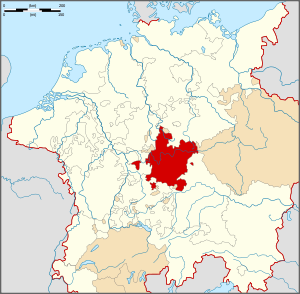Schwarzenberg family
| House of Schwarzenberg | |
|---|---|
 Arms of the Princes of Schwarzenberg | |
| Style(s) | Serene Highness |
| Founded | 12th century |
| Founder | Erkinger of Seinsheim |
| Current head | Karel VII of Schwarzenberg |
| Ethnicity | |
| (Princely) County of Schwarzenberg | ||||||||
| (Gefürstete) Grafschaft Schwarzenberg | ||||||||
| State of the Holy Roman Empire | ||||||||
| ||||||||
|
| ||||||||
| Capital | Schwarzenberg Castle, Scheinfeld; Český Krumlov (de facto since 1670s) | |||||||
| Government | Principality | |||||||
| Historical era | Late Middle Ages Early Modern Era | |||||||
| • | Acquired by the lords of Seinsheim | 1405 – 1421 | ||||||
| • | Imperial immediacy | 1429 | ||||||
| • | Raised to Imperial County |
1599 | ||||||
| • | Raised to Princely County |
14 July 1670 | ||||||
| • | Raised to Princely Landgraviate |
1671 | ||||||
| • | German Mediatisation | 1806 | ||||||
| ||||||||
Schwarzenberg (formerly in Czech too: Schwarzenberg) is the name of a Czech (Bohemian) and German (Franconian) aristocratic family, and it was one of the most prominent European noble houses. The Schwarzenbergs are members of the Bohemian nobility and German nobility and achieved the rank of Princes of the Holy Roman Empire. The family traces its roots to the lords of Seinsheim during the Middle Ages.[1]
The current head of the family is Karl, the 12th Prince of Schwarzenberg, a Czech politician who served as Minister of Foreign Affairs of the Czech Republic. The family owns properties and lands across Austria, Czech Republic and Germany.
History
The family stems from the lords of Seinsheim, who had established themselves in Franconia during the Middle Ages.[1] A branch of the Seinsheim family (the non-Schwarzenberg portion died out in 1958) was created when Erkinger of Seinsheim acquired the Franconian territory of Schwarzenberg and the castle of Schwarzenberg in Scheinfeld during the early part of the 15th century. He was then granted the title of Freiherr (Baron) of Schwarzenberg in 1429. At that time, the family also possessed some fiefdoms in Bohemia.
In 1599, the Schwarzenbergs were elevated to Imperial Counts, and the family was later raised to princely status in 1670.[1] The House of Schwarzenberg acquired extensive land holdings in Bohemia in 1661 through a marriage alliance with the House of Eggenberg. In the 1670s, the Schwarzenbergs established their primary seat in Bohemia and, until 1918, their main residence was in Český Krumlov, Bohemia (now in the Czech Republic).
At the beginning of the 19th century, the House of Schwarzenberg was divided into two princely-titled lines (majorats).[1] The senior branch died out in the male line in 1979 upon the death of Joseph III of Schwarzenberg, who was the 11th Prince of Schwarzenberg. The cadet branch was established by Karl Philipp, Prince of Schwarzenberg, at Orlík, Murau and Vienna, and this branch continues to the present day.
The two branches have now been re-united under the current head of the family, Karl VII of Schwarzenberg, who is the 12th Prince of Schwarzenberg. He is a Czech politician and served as Minister of Foreign Affairs of the Czech Republic.
Imperial Immediate Estates
The Schwarzenberg family held three Imperial Immediate Estates in the Holy Roman Empire.
| Name | Timespan | Map | Coat of Arms | Historic Map |
|---|---|---|---|---|
| Princely County of Schwarzenberg Gefürstete Grafschaft Schwarzenberg |
1429 - 1806 |  Schwarzenberg Schwarzenberg (Germany) |
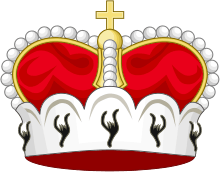 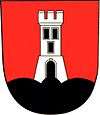 |
 |
| Princely Landgraviate of Klettgau Gefürstete Landgrafschaft Klettgau |
1694 - 1806 |  Klettgau Klettgau (Germany) |
 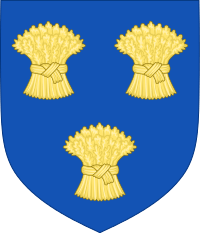 |
|
| County of Gimborn Grafschaft Gimborn |
1658 - 1782 |  Gimborn Gimborn (Germany) |
  |
 |
By coincidence the coat of arms of the Princely Landgraviate of Klettgau and the Earldom of Buchan in Scottland are the same. The Klettgau coat of arms can be found in the left heart shield of the Schwarzenberg coat of arms.
Coat of arms
Family Coat of Arms
The ancestral arms of the Lords of Seinsheim consisted of six vertical stripes in silver and blue.[2] However, the Schwarzenberg family's original coat of arms has four silver and four blue vertical stripes. Moreover, it starts with silver on the heraldic right (mirror-inverted perspective).
The family became Freiherren (Barons) of Schwarzenberg in 1429, and a silver tower on a black hill was added to their coat of arms to represent the city Scheinfeld and Schwarzenberg Castle.[2]

In 1599, Adolf von Schwarzenberg became an Imperial Count, and was given by the emperor a quarter showing the head of a Turk being pecked by a raven. This was to commemorate Adolf's conquest on 19 March 1598 of the Turkish-held fortress and city Győr. The German name of the Hungarian town is Raab, which means raven.[3][4][5]
In 1670, the Schwarzenbergs were raised to princely status. However, only the marriage of Ferdinand, The 2nd Prince of Schwarzenberg (1652–1703) with Marie Anna Countess of Sulz (1653–1698), the daughter of Johann Ludwig II. Count of Sulz (1626–1687), led to the augmenting of their coat of arms, with quarters added for the domains of Sulz, Brandis (canting arms: a brand) and the Landgraviate of Klettgau.[3][6] Due to the absence of a male heir, Count Rudolf requested at the imperial court that the two families should be consolidated. This was granted, which meant for the Schwarzenberg family not only to assume all titles, rights and duties of the Counts of Sulz, but also to inherit all of Rudolf's properties.
The last augmentation of the family coat of arms was granted by the Austrian Emperor Franz II. / I. . He rewarded Field Marshal Karl I. Philipp Prince of Schwarzenberg with the right to bear the three-part arms of the Habsburg family with the addition of an upright standing sword. This unique distinction was granted to commemorate the field marshal's victory in the Battle of the Nations, where he was the Generalissimo of the Sixth Coalition.
The family motto is NIL NISI RECTUM.
 Lords of Seinsheim
Lords of Seinsheim Freiherren of Schwarzenberg
Freiherren of Schwarzenberg Counts of Schwarzenberg
Counts of Schwarzenberg Schwarzenberg Primogeniture (Frauenberg branch)
Schwarzenberg Primogeniture (Frauenberg branch) Schwarzenberg Secundogeniture (Orlík branch)
Schwarzenberg Secundogeniture (Orlík branch)
Municipal Coat of Arms
Traces of the Schwarzenberg coat of arms can be found in various district and municipal coat of arms, which can be linked to the family
 Coat of arms of the Landkreis Neustadt a.d.Aisch-Bad Windsheim
Coat of arms of the Landkreis Neustadt a.d.Aisch-Bad Windsheim Coat of arms of the former Landkreis Scheinfeld
Coat of arms of the former Landkreis Scheinfeld Former coat of arms of the Landkreis Kitzingen
Former coat of arms of the Landkreis Kitzingen Municipal coat of arms of Scheinfeld
Municipal coat of arms of Scheinfeld Municipal coat of arms of Seinsheim
Municipal coat of arms of Seinsheim Municipal coat of arms of Marktbreit
Municipal coat of arms of Marktbreit Municipal coat of arms of Markt Nordheim
Municipal coat of arms of Markt Nordheim Municipal coat of arms of Martinsheim
Municipal coat of arms of Martinsheim Municipal coat of arms of Biebelried
Municipal coat of arms of Biebelried Municipal coat of arms of Willanzheim
Municipal coat of arms of Willanzheim.png) Coat of arms of the district Astheim in Volkach
Coat of arms of the district Astheim in Volkach Coat of arms of the district Dornheim in Iphofen
Coat of arms of the district Dornheim in Iphofen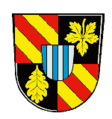 Municipal coat of arms of Weigenheim
Municipal coat of arms of Weigenheim Municipal coat of arms of Orlík nad Vltavou
Municipal coat of arms of Orlík nad Vltavou Municipal coat of arms of Protivín
Municipal coat of arms of Protivín Municipal coat of arms of Tochovice
Municipal coat of arms of Tochovice Municipal coat of arms of Libějovice
Municipal coat of arms of Libějovice Municipal coat of arms of Zvíkovské Podhradí
Municipal coat of arms of Zvíkovské Podhradí Municipal coat of arms of Modrava
Municipal coat of arms of Modrava Flag of Dobrá Voda u Českých Budějovic
Flag of Dobrá Voda u Českých Budějovic Flag of Dolní Dvořiště
Flag of Dolní Dvořiště_znak.jpg) Municipal coat of arms of Domanín (Jindřichův Hradec District)
Municipal coat of arms of Domanín (Jindřichův Hradec District) Municipal coat of arms of Doňov
Municipal coat of arms of Doňov Municipal coat of arms of Dynín
Municipal coat of arms of Dynín
 Flag of Chýnov
Flag of Chýnov Municipal coat of arms of Lenora (Prachatice District)
Municipal coat of arms of Lenora (Prachatice District)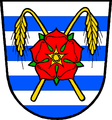 Municipal coat of arms of Neplachov
Municipal coat of arms of Neplachov Municipal coat of arms of Nová Ves (České Budějovice District)
Municipal coat of arms of Nová Ves (České Budějovice District) Municipal coat of arms of Novosedly nad Nežárkou
Municipal coat of arms of Novosedly nad Nežárkou Municipal coat of arms of Paseky (Písek District)
Municipal coat of arms of Paseky (Písek District) Municipal coat of arms of Wasterkingen
Municipal coat of arms of Wasterkingen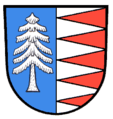 Municipal coat of arms of Klettgau
Municipal coat of arms of Klettgau Municipal coat of arms of Dietingen
Municipal coat of arms of Dietingen Coat of arms of the former municipality of Gößlinge
Coat of arms of the former municipality of Gößlinge Municipal coat of arms of Walterswil, Bern
Municipal coat of arms of Walterswil, Bern Municipal coat of arms of Hohentengen am Hochrhein
Municipal coat of arms of Hohentengen am Hochrhein Coat of arms of the district of Bergöschingen in Hohentengen am Hochrhein
Coat of arms of the district of Bergöschingen in Hohentengen am Hochrhein Coat of arms of the district of Stetten in Hohentengen am Hochrhein
Coat of arms of the district of Stetten in Hohentengen am Hochrhein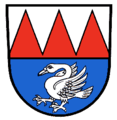 Municipal coat of arms of Lauchringen
Municipal coat of arms of Lauchringen Municipal coat of arms of Mötzing
Municipal coat of arms of Mötzing Municipal coat of arms of Schnelldorf
Municipal coat of arms of Schnelldorf
Notable family members
The House of Schwarzenberg produced many military commanders, politicians, church dignitaries (including a Cardinal), innovators and patrons of the arts.[1] They were related to a number of European aristocratic families, notably the Lobkowicz (Czech: Lobkovicové) family. Some of the most noteworthy members of the Schwarzenberg family are:
| Name | Portrait | Arms | Office(s) | Marriage(s) Issue |
Comments |
|---|---|---|---|---|---|
| Erkinger VI. of Seinsheim, 1st Baron of Schwarzenberg 1362 – 11 December 1437 |
 |
 |
Grand Master of the Hunt at the Court of the Bishopric of Würzburg | I. Anna von Bibra 1348 – 1408 Six children II. Barbara von Abensberg 1383 – 2 November 1448 Eleven children |
Founder of the Schwarzenberg family Member of the Imperial Council Military commander in the Hussite Wars |
| Johann Baron of Schwarzenberg Johann the Strong 25 December 1463 – 21 October 1528 |
 |
 |
Judge of the episcopal court at Bamberg | Kunigunde, Countess of Rieneck 28 September 1469 – 18 October 1502 twelve children |
Friend of Martin Luther, and author of the Constitutio Criminalis Bambergensis, which was the basis for the Constitutio Criminalis Carolina |
| Melchior of Schwarzenberg ca. 1536 – KIA 29 June 1579 |
 |
Military Commander Military Governor |
Anne de Merode-Houffalize ca. 1530 – 1580 |
Commander of the Dutch States Party military forces in the Siege of Maastricht and Military Governor of Maastricht | |
| Adolf, Count of Schwarzenberg ca. 1547 – 29 July 1600 |
.jpg) |
 |
Field marshal | Elisa Margareta von Wolff Metternich ? – 6 February 1624 one son |
Field marshal of the Holy Roman Empire and liberator of Győr (German: Raab) |
| Adam, Count of Schwarzenberg 1583 – 14 March 1641 |
 |
 |
Herrenmeister (Grand Master) Political advisor |
Margareta, Freiin von Palant von Larochette und Moestroff ? – 29 September 1615 two sons |
Advisor of George William, Elector of Brandenburg, Herrenmeister (Grand Master) of the Order of Saint John Son of Adolf, Count of Schwarzenberg |
| Georg Ludwig, Count of Schwarzenberg 24 December 1586 – 22 July 1646 |
 |
Statesman | I. Anna Neumann von Wasserleonburg 25 November 1536 – 18 December 1623 no issue II. Maria Elisabeth Countess of Sulz 1587 – 12 December 1651 two sons |
Austrian statesman during the Thirty Years War Through his marriage with Anna Neumann came the Dominion of Murau into the Schwarzenberg family | |
| Ferdinand, 2nd Prince of Schwarzenberg The Plague King 23 May 1652 – 22 October 1703 |
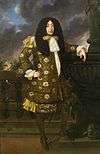 |
 |
Oberhofmarschall Oberhofmeister |
Maria Anna Countess of Sulz ca. 1660 – 18 July 1698 eleven children |
Oberhofmarschall and Oberhofmeister, known as the Plague King (Pestkönig) |
| Adam Franz, 3rd Prince of Schwarzenberg Duke of Krumlov 25 September 1680 – 11 Juni 1732 |
 |
 |
Obersthofmarschall (1711–1722) Oberstallmeister (1722–1732) |
Eleonore Princess of Lobkowicz 20 June 1682 – 5 May 1741 two children |
First Duke of Krumlov, Count of Sulz and Princely Landgrave of Klettgau in the Schwarzenberg family Initiator of the Schwarzenberg Navigational Canal Killed accidentally by Emperor Charles VI during a driven shoot |
| Joseph I., 4th Prince of Schwarzenberg Duke of Krumlov 15 December 1722 – 17 February 1782 |
 |
 |
Obersthofmeister | Maria Theresia Princess von und zu Liechtenstein 28 December 1721 – 19 January 1753 nine children |
Obersthofmeister of Empress Maria Theresia, Minister of State, receives the Order of the Golden Fleece at the age of ten |
| Joseph II., 6th Prince of Schwarzenberg Duke of Krumlov 27 June 1769 – 19 December 1833 |
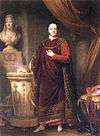 |
 |
Ambassador | Pauline Princess of Arenberg-Aarschot 2 September 1774 – burned to death in the night of 1st to the 2nd July 1810 nine children |
Ambassador of the Austrian Empire in Paris Last Prince of Schwarzenberg, who possessed the imperial immediacy Founder of the Schwarzenberg Primogeniture |
| Karl I. Philipp Prince of Schwarzenberg Duke of Krumlov 15 April 1771 – 15 October 1820 |
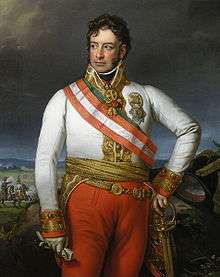 |
 |
Field marshal Ambassador |
Maria Anna Countess von Hohenfeld widowed Princess Esterházy 20 May 1768 – 2 April 1848 three sons |
Austrian field marshal during the Napoleonic Wars and ambassador in St.Petersburg and Paris, Generalissimo of the Sixth Coalition in the Battle of the Nations at Leipzig Founder of the Schwarzenberg Secundogeniture |
| Ernst Prince of Schwarzenberg Duke of Krumlov 29 May 1773 – 14 March 1821 |
 |
Bishop | - | Canon of Cologne, Liège, Salzburg, Passau, Esztergom and Bishop of Győr | |
| Felix Prince of Schwarzenberg The Austrian Bismarck Duke of Krumlov 2 October 1800 – 5 April 1852 |
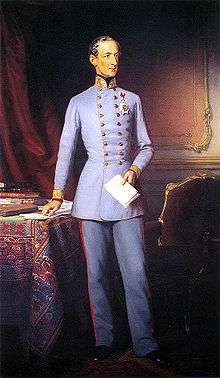 |
 |
Minister-President Minister of Foreign Affairs Field Marshal Lieutenant |
Two children with Jane Digby, Lady Ellenborough | Minister-President of the Austrian Empire between 1848 and 1852 |
| Friedrich Prince of Schwarzenberg The Lansquenet 30 September 1800 – 6 March 1870 |
 |
 |
Major General Writer |
- | Major general of the Austrian Empire, Colonel of the General Staff in the Spanish First Carlist War, officer in the Swiss Sonderbund War and author, known as der Landsknecht (the Lansquenet) |
| Karl II. Prince of Schwarzenberg The Governor 21 January 1802 – 25 June 1858 |
 |
 |
General of the branch (Military) Governor |
Josephine Countess Wratislaw of Mitrovic 16 April 1802 – 17 April 1881 one son |
General of the branch of the Austrian Empire, Military Governor of Milan and Governor of the Principality of Transylvania (today Romania), known as der Gouverneur (the governor) |
| Edmund Prince of Schwarzenberg 18 November 1803 – 17 November 1873 |
 |
 |
Field marshal | - | Last Austrian field marshal in the 19th century |
| Friedrich Prince of Schwarzenberg Duke of Krumlov 6 April 1809 – 27 March 1885 |
 |
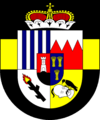 |
Cardinal Archbishop |
- | Cardinal and Archbishop of Salzburg, then Archbishop of Prague |
| Felix Prince of Schwarzenberg Duke of Krumlov 8 June 1867 – 18 November 1946 |
 |
Major general | Anna Princess zu Löwenstein-Wertheim-Rosenberg 28 September 1873 – 27 June 1936 five children |
Major general in World War I, one of only two recipients of the Golden Medal of Bravery for Officers by Emperor Charles I. | |
| Heinrich Prince of Schwarzenberg Duke of Krumlov 29 January 1903 – 18 June 1965 |
 |
Public servant | Eleonore Countess zu Stolberg-Stolberg 8 August 1920 – 27 Dezember 1994 one daughter |
Austrian public servant and survivor of the Buchenwald concentration camp | |
| Johannes Prince of Schwarzenberg 31 January 1903 – 26 May 1978 |
 |
Public servant | Kathleen Vicomtesse de Spoelberch 19 May 1905 – 26 May 1978 two children |
Austrian ambassador in Italy (1947–1955), to the Holy See (1955–1966) and Ambassador to the Court of St James's (1966–1969), Director and Delegate of the Red Cross and member of the Governing Board | |
| Karl VI., Prince of Schwarzenberg 5 July 1911 – 9 April 1986 |
 |
Officer Regent Author |
Antonia Princess zu Fürstenberg 12 January 1905 – 24 December 1988 four children |
Czech resistance fighter in World War II, Regent of the Grand Priory of Bohemia of the Order of Malta, historian and author | |
| Karl, 12th Prince of Schwarzenberg 10 December 1937 |
 |
 |
President of the Council of the European Union Minister of Foreign Affairs Vice prime minister Senator |
Therese Countess zu Hardegg auf Glatz und im Machlande 17 February 1940 two children |
Czech politician, former Minister of Foreign Affairs (Czech Republic) and current head of the House of Schwarzenberg |
Property and Residences
Bohemia
The Schwarzenberg land holdings in Bohemia included the Duchy of Krumlov, the town of Prachatice and Orlík Castle. The family also acquired the property of the House of Rosenberg (Czech: Rožmberkové). On their lands, the Schwarzenbergs created ponds, planted forests and introduced new technologies in agriculture.[1]
Upon the establishment of the Protectorate of Bohemia and Moravia in 1939, the possessions of Prince Adolph of Schwarzenberg were seized by the Nazi authorities. He managed to flee, but his cousin Heinrich, Duke of Krumlov, was arrested and deported. After World War II, the Czechoslovakian government stated, by law No. 143/1947 from August 13, 1947 (Lex Schwarzenberg), that the assets of the Schwarzenberg-Hluboká primogeniture passed to the Land of Bohemia.[1]
Castles and Palaces
The Schwarzenberg property holdings included the following residences:
| Name | Image | Location | Map | Comments |
|---|---|---|---|---|
| Schwarzenberg Castle | |
Scheinfeld, Franconia |  Scheinfeld Scheinfeld (Germany) |
Ancestral seat Held to present |
| Krumlov Castle Krumau Castle |
 |
Český Krumlov, South Bohemia | 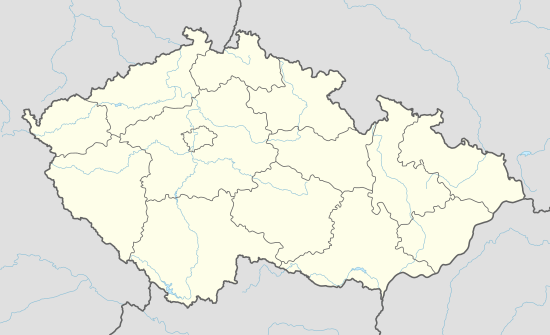 Český Krumlov Český Krumlov (Czech Republic) |
Held from 1719 until the expropriation in 1947 UNESCO World Heritage Site One of the largest castles in the world |
| Hluboká Castle Frauenberg Castle |
 |
Hluboká nad Vltavou, South Bohemia |  Hluboká nad Vltavou Hluboká nad Vltavou (Czech Republic) |
Acquired by Johann Adolf I of Schwarzenberg in 1661 Held until the expropriation in 1947 One of the finest examples of Neo-Tudor architecture in Historicism |
| Vimperk Castle Winterberg Castle |
|
Vimperk, South Bohemia |  Vimperk Vimperk (Czech Republic) |
Acquired in 1698 Held until the expropriation in 1947 |
| Třeboň Castle Wittingau Castle |
|
Třeboň, South Bohemia |  Třeboň Třeboň (Czech Republic) |
Acquired in 1698 Held until the expropriation in 1947 |
| Orlík Castle Worlik Castle |
 |
Orlík nad Vltavou, South Bohemia |  Orlík nad Vltavou Orlík nad Vltavou (Czech Republic) |
Main residence of the Schwarzenberg Secundogeniture Restored in 1992 Held to present Publicly accessible |
| Čimelice Castle | .jpg) |
Čimelice, South Bohemia |  Čimelice Čimelice (Czech Republic) |
Spring and summer residence of the Schwarzenberg Secundogeniture Restored in 1992 Held to present |
| Karlov Castle | .jpg) |
Karlov (Smetanova Lhota), South Bohemia |  Karlov Karlov (Czech Republic) |
Restored in 1992 Held to present |
| Zvíkov Castle Zwingenberg Castle |
 |
Zvíkov, South Bohemia |  Zvíkov Zvíkov (Czech Republic) |
Publicly accessible |
| Palais Schwarzenberg |  |
Schwarzenbergplatz, Landstraße, Vienna |  Vienna Vienna (Austria) |
Acquired in 1716 Held to present |
| Palais Schwarzenberg |  |
Neuer Markt, Innere Stadt, Vienna |  Vienna Vienna (Austria) |
Acquired in 1688 1894 demolished |
| Neuwaldegg Castle Villa Schwarzenberg |
|
Hernals, Vienna |  Vienna Vienna (Austria) |
Acquired in 1801 Sold in 1951 |
| Palais Schwarzenberg |  |
Graz, Styria |  Graz Graz (Austria) |
Acquired in 1775 Sold in 1853/54 |
| Murau Castle Obermurau Castle |
 |
Murau, Styria |  Murau Murau (Austria) |
Publicly accessible on appointment Held to present |
| Palais Schwarzenberg Schwarzenberský palác |
|
Prague |  Prague Prague (Czech Republic) |
Acquired in 1719 Held until the expropriation in 1947 Publicly accessible |
| Palais Salm Salmovský palác Small Palais Schwarzenberg |
 |
Prague |  Prague Prague (Czech Republic) |
Acquired in 1811 Held until the expropriation in 1947 |
| Schwarzenberg Palais | |
Frickenhausen am Main, Lower Franconia |  Frickenhausen am Main Frickenhausen am Main (Germany) |
|
| Tiengen Castle | |
Waldshut-Tiengen, Baden-Württemberg |  Waldshut-Tiengen Waldshut-Tiengen (Germany) |
Acquired in 1687 Sold in 1812 |
| Gimborn Castle |  |
Marienheide, North Rhine-Westphalia |  Marienheide Marienheide (Germany) |
From 1631 on the residence in the imperial immediate Dominion of Gimborn of the Schwarzenberg Family Sold in 1782 to Johann Ludwig, Reichsgraf von Wallmoden-Gimborn |
Ecclesiastical Buildings and Places
| Name | Image | Location | Map | Comments |
|---|---|---|---|---|
| Astheim Charterhouse | |
Volkach, Franconia |  Volkach Volkach (Germany) |
Founded by Erkinger, 1st Baron of Schwarzenberg in 1409 First burial site of the Schwarzenberg family |
| St. Vitus Cathedral Schwarzenberg Chapel |
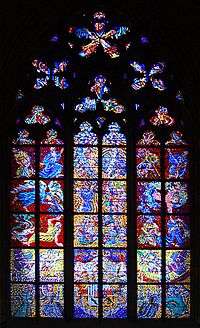 |
Prague, Czech Republic |  Prague Prague (Czech Republic) |
Located in the St. Vitus Cathedral. |
| Schwarzenberg Crypt (Domanín) |  |
Domanín (Jindřichův Hradec District), Czech Republic |  Schwarzenberg Crypt (Domanín) Schwarzenberg Crypt (Domanín) (Czech Republic) |
Constructed from 1874 - 1877. Burial sight of the Schwarzenberg Primogeniture. |
| Schwarzenberg Crypt (Orlík nad Vltavou) | .jpg) |
Orlík nad Vltavou, Czech Republic |  Schwarzenberg Crypt (Orlík nad Vltavou) Schwarzenberg Crypt (Orlík nad Vltavou) (Czech Republic) |
Burial sight of the Schwarzenberg Secundogeniture. In family possession Active in use and not open to the public. |
| Sedlec Ossuary | |
Orlík nad Vltavou, Czech Republic |  Sedlec Ossuary in Kutná Hora Sedlec Ossuary in Kutná Hora (Czech Republic) |
Large Schwarzenberg Secundogeniture coat of arms made out of human bones. |
| St. Laurentius Church | |
Weinheim, Germany |  St. Laurentius Church St. Laurentius Church (Germany) |
Tomb of Rittmeister Friedrich Prinz zu Schwarzenberg. |
Monuments and Memorials
| Name | Picture | Map | Comment |
|---|---|---|---|
| Schwarzenbergplatz |  |
 Schwarzenbergplatz Schwarzenbergplatz (Austria) |
Inaugurated in 1867 Commemorating the victory of Karl Philipp Schwarzenberg at the Battle of the Nations in 1813 |
| Monument to the Battle of the Nations |  |
 Monument to the Battle of the Nations Monument to the Battle of the Nations (Germany) |
Inaugurated in 1913 Commemorating the victory (of Karl Philipp Schwarzenberg) at the Battle of the Nations in 1813 Length: 80 metres (260 ft) Width: 70 metres (230 ft) Height: 91 metres (299 ft) |
| Schwarzenberg-Pálffy Monument |  |
 Schwarzenberg-Pálffy Monument Schwarzenberg-Pálffy Monument (Hungary) |
Inaugurated in 1998 Commemorating the victory at the Battle of Györ of Adolf Schwarzenberg in 1598 |
| Statue of Cardinal Friedrich Schwarzenberg |  |
 Prague Prague (Czech Republic) |
Located in the St. Vitus Cathedral in the Prague Castle Memorial to Cardinal Friedrich Schwarzenberg |
| Schwarzenberg Monument in Meusdorf (Leipzig) |  |
Inaugurated in 1838 Commemorating the victory of Karl Philipp Schwarzenberg at the Battle of the Nations in 1813 Commissioned by Karl Philipp's wife and his three sons | |
| Schwarzenberg Memorial on the peak of Plattenkogel Mountain |  |
 Plattenkogel Plattenkogel (Austria) |
Commemorating the presence of Cardinal Friedrich Schwarzenberg |
| Walhalla Memorial Bust of Karl Philipp Schwarzenberg |
.jpg) Second from the right in the lowest row |
 Donaustauf Donaustauf (Germany) |
Inaugurated in 1842 Commemorating the victory of Karl Philipp Schwarzenberg at the Battle of the Nations in 1813 The original bust was created by Johann Nepomuk Schaller in 1821 |
| Ruhmeshalle (Munich) Bust of Karl Philipp Schwarzenberg |
 |
 Munich Munich (Germany) |
Inaugurated in 1853 |
| Heldenberg Memorial Bust of Karl Philipp Schwarzenberg |
Located on the balustrade next to the portico |
 Heldenberg Memorial Heldenberg Memorial (Austria) |
Inaugurated in 1849 One of four Schwarzenberg busts in the Heldenberg Memorial |
| Heldenberg Memorial Bust of Edmund Schwarzenberg |
 |
 Heldenberg Memorial Heldenberg Memorial (Austria) |
Inaugurated in 1849 One of four Schwarzenberg busts in the Heldenberg Memorial |
| Heldenberg Memorial Bust of Adolf Schwarzenberg |
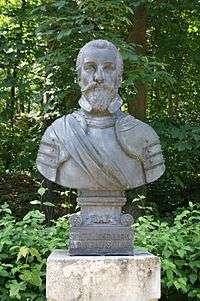 |
 Heldenberg Memorial Heldenberg Memorial (Austria) |
Inaugurated in 1849 One of four Schwarzenberg busts in the Heldenberg Memorial |
| Heldenberg Memorial Bust of Felix Schwarzenberg |
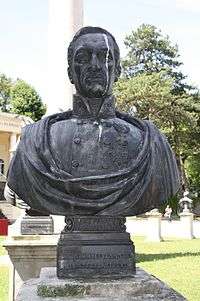 |
 Heldenberg Memorial Heldenberg Memorial (Austria) |
Inaugurated in 1849 One of four Schwarzenberg busts in the Heldenberg Memorial |
Heads of the Family and Title Progression

Lords of Seinsheim The House of Seinsheim regarded Erchanger, Duke of Swabia (died 917), as their ancestor.[2]
- Conrad
- ...
- Apollonius d. Ä. (died 1311)
- ...
- Hildebrand (IV.) (died 1386)
- Michael (I.) (died 1399)
- Erkinger (VI.) (1362–1437) founded Astheim Charterhouse in 1409 with his first wife Anna von Bibra, acquired Schwarzenberg in 1420, became baron of Schwarzenberg in 1429 and bought Hohenlandsberg (49°35′42″N 10°17′53″E / 49.595034°N 10.297960°E) in 1435.[1] All Schwarzenbergs descend from Erkinger and his two wives, Anna von Bibra (died 1418) and Barbara von Abensberg (died 1448).[7]
Barons of Schwarzenberg
- 1420–1437: Erkinger I (same as Erkinger VI above)
- 1437–1469: Michael II
- 1469–1499: Michael III
- 1499–1510: Erkinger II
- 1510–1526: Wilhelm I
- 1526–1557: Wilhelm II
- 1557–1599: Adolf, became a count in 1599 (see below)
In 1599, the barony was raised to an Imperial county.
Counts of Schwarzenberg
On 14 July 1670, the county was raised to an Princely county and, the following year, to a Princely landgraviate.


Princes of Schwarzenberg
- 1670–1683: Johann Adolf I
- 1683–1703: Ferdinand Wilhelm Eusebius
- 1703–1732: Adam II Franz Karl, Duke of Krumlov from 1723
- 1732–1782: Joseph I Adam
- 1782–1789: Johann I
|
Primogeniture (branch of Krumlov and Hluboká)
|
Secundogeniture (branch of Orlík)
|
In November of 1918, the Austro-Hungarian Empire ceased to exist.
Heads of the House of Schwarzenberg (after 1918)
|
Primogeniture
|
Secundogeniture
|
- 1979–present: Karel VII, son of Karl VI, adopted by Heinrich, thus unifying both lines
The Dynasty
The names hereby presented are those of all the direct successors of the Prince John I of Schwarzenberg (1742–1789). They have been respectively divided into the two brenches of Krumlov and Orlik, including the contemporary generations. For the genealogy to be easier to consult, the male successors alone are listed, and they are accompanied with remarkable informations whether necessary. In bold the names of the members of the eldest part of the family.
- Jan I Nepomuk (1742–1789), 5th Prince of Schwarzenberg, 10th (3rd of his line) Duke of Krumlov
- A1. Josef II Jan (1769–1833), 6th Prince of Schwarzenberg, 11th (4th of his line) Duke of Krumlov (1789–1833), founder of the main branch of the family (that of Frauenberg-Krummau)
- B1. Jan Adolf II (1799–1888), 7th Prince of Schwarzenberg, 12th (5th of his line) Duke of Krumlov (1833–1888)
- C1. Adolf Josef (1832–1914), 8th Prince of Schwarzenberg, 13th (6th of his line) Duke of Krumlov (1888–1914)
- D1. Jan II Nepomuk (1860–1938), 9th Prince of Schwarzenberg, 14th (7th of his line) Duke of Krumlov (1914–1938)
- E1. Adolph Jan (1890–1950), 10th Prince of Schwarzenberg, 15th (8th of his line) Duke of Krumlov (1938–1950)
- E2. Karl (1892–1919)
- E3. Edmund Černov (1897–1932), Called "Black Sheep" as a consequence of the refusal of his surname
- D2. Alois (1863–1937)
- D3. Felix (1867–1946)
- E1. Josef III (1900–1979), 11th Prince of Schwarzenberg (1950–1979), last member of the eldest side of the dynasty
- E2. Heinrich (1903–1965), 16th (9th of his line) Duke of Krumlov (1950–1965) (adopted G1. Karel (VII/I))
- D4. Georg (1867–1952)
- D5. Karel (1871–1902)
- D1. Jan II Nepomuk (1860–1938), 9th Prince of Schwarzenberg, 14th (7th of his line) Duke of Krumlov (1914–1938)
- C2. Cajus (1839–1941)
- C1. Adolf Josef (1832–1914), 8th Prince of Schwarzenberg, 13th (6th of his line) Duke of Krumlov (1888–1914)
- B2. Felix (1800–1852), Prime Minister of the Austrian Empire
- B3. Friedrich (1809–1885), Archbishop of Prague
- B1. Jan Adolf II (1799–1888), 7th Prince of Schwarzenberg, 12th (5th of his line) Duke of Krumlov (1833–1888)
- A2. Karel I Philipp (1771–1820), Prince of Schwarzenberg, founder and chief of the second line of the family (Orlík)
- B1. Friedrich (1800–1870), Who renounced his right of majorat in favour of his brother
- B2. Karel II (1802–1858), Prince of Schwarzenberg
- C1. Karel III (1824–1904), Prince of Schwarzenberg
- D1. Karel IV (1859–1913), Prince of Schwarzenberg
- E1. Karl V (1886–1914), Prince of Schwarzenberg
- F1. Karel VI (1911–1989), Prince of Schwarzenberg
- G1. Karel (VII / I) Schwarzenberg (born 1937), 12th Prince of Schwarzenberg (from 1979), 17th (10th considering his original line) Duke of Krumlov (from 1965), Former Minister of the Foreign Affairs and candidate to the head of state for Czech Republic in 2013. He unified the two lines of the family.
- H1. Jan Nepomuk (born 1967)
- G2. Friedrich (1940–2014)
- H1. Ferdinand (born 1989)
- G1. Karel (VII / I) Schwarzenberg (born 1937), 12th Prince of Schwarzenberg (from 1979), 17th (10th considering his original line) Duke of Krumlov (from 1965), Former Minister of the Foreign Affairs and candidate to the head of state for Czech Republic in 2013. He unified the two lines of the family.
- F2. Franz Friedrich Maria (1913–1992), Who strongly opposed Nazi rule in Bohemia.
- G1. Johann (born 1957)
- H1. Alexander (born 1984)
- G1. Johann (born 1957)
- F1. Karel VI (1911–1989), Prince of Schwarzenberg
- E2. Ernst (1892–1979)
- E3. Josef (1894–1894)
- E4. Jan Nepomuk (1903–1978), Austrian Embassador
- F1. Erkinger (born 1933)
- G1. Jan (born 1963)
- G2. Alexandr (born 1971)
- H1. Karl Philipp (born 2003)
- F1. Erkinger (born 1933)
- E1. Karl V (1886–1914), Prince of Schwarzenberg
- D2. Friedrich (1862–1936)
- D1. Karel IV (1859–1913), Prince of Schwarzenberg
- C1. Karel III (1824–1904), Prince of Schwarzenberg
- B2. Leopold (1803–1873), Austrian Marshal
- A1. Josef II Jan (1769–1833), 6th Prince of Schwarzenberg, 11th (4th of his line) Duke of Krumlov (1789–1833), founder of the main branch of the family (that of Frauenberg-Krummau)
_____________
Multiple attempts have been made to include Hugo Tiberius (born 1936), Lukas (born 1963), Egon Hildebrand (born 1996) in this list. None of them are related to the House of Schwarzenberg.
Titles of the Members of the Schwarzenberg family
| Styles of The Prince of Schwarzenberg | |
|---|---|
 | |
| Reference style | His Serene Highness |
| Spoken style | Your Serene Highness |
| Alternative style | Sir |
The title of the head of the princely family is:
- HSH The Prince of Schwarzenberg, Duke of Krumlov, Count of Sulz, Princely Landgrave of Klettgau
The title of the wife of the head of the family would be:
- HSH The Princess of Schwarzenberg, Duchess of Krumlov, Countess of Sulz, Princely Landgravine of Klettgau
- (German: I.D. die Fürstin zu Schwarzenberg, Herzogin von Krummau, Gräfin von Sulz, gefürstete Landgräfin im Klettgau)
The title of the first born son and heir of the family is:
- HSH The Hereditary Prince of Schwarzenberg, Duke of Krumlov, Count of Sulz, Landgrave of Klettgau
- (German: S.D. der Erbprinz zu Schwarzenberg, Herzog von Krummau, Graf von Sulz, Landgraf im Kledage)
The title of the wife of the first born son and heir of the family would be:
- HSH The Hereditary Princess of Schwarzenberg, Duchess of Krumlov, Countess of Sulz, Landgravine of Klettgau
- (German: I.D. die Erbprinzessin zu Schwarzenberg, Herzogin von Krummau, Gräfin von Sulz, Landgräfin im Klettgau)
The title of all other female members of the family is:
- HSH Princess Name of Schwarzenberg, Countess of Sulz, Landgravine of Klettgau
- (German: I.D. Prinzessin Name zu Schwarzenberg, Gräfin von Sulz, Landgräfin im Klettgau)
The title of all other male members of the family is:
- HSH Prince Name of Schwarzenberg, Count of Sulz, Landgrave of Klettgau
- (German: S.D. Prinz Name zu Schwarzenberg, Graf von Sulz, Landgraf im Klettgau)
Although the family is entitled to use the von und zu, only the zu is applied. Moreover, all members of the family are allowed to use the title Fürst / Fürstin. However, this is not anymore practiced since the late 19th century and the cognates refer to themselves as Prinz / Prinzessin.
References
- 1 2 3 4 5 6 7 8 "Schwarzenbergs". Retrieved 13 November 2016.
- 1 2 3 "European Heraldry :: House of Schwarzenberg". Retrieved 13 November 2016.
- 1 2 "The Schwarzenberg Coat-of-arms". Retrieved 13 November 2016.
- ↑ Sugar, Peter F.; Hanák, Péter; Frank, Tibor, eds. (1990). A History of Hungary. Bloomington: Indiana University Press. p. 97.
- ↑ Slater, Stephen (2013). The Illustrated Book of Heraldry: An International History of Heraldry and Its Contemporary Uses. Wigston, Leicestershire: Lorenz Books. pp. 234, 240–241. ISBN 978-0-7548-2659-0.
- ↑ CRnet.cz. "Informační servis města Třeboně". Retrieved 13 November 2016.
- ↑ "Schwarzenberg 1". Retrieved 13 November 2016.
External links
| Wikimedia Commons has media related to House of Schwarzenberg. |
| Wikisource has the text of a 1911 Encyclopædia Britannica article about Schwarzenberg. |
- Marek, Miroslav. "Family tree of the House of Schwarzenberg". Genealogy.EU. External link in
|publisher=(help) - Family history and pictorial family tree
- The Schwarzenberg coat of arms
- Heraldry of the House of Schwarzenberg
- Description of the arms of the Princes of Schwarzenberg (Orlik branch) (in German)
- Almanach de Gotha info on the House of Schwarzenberg
